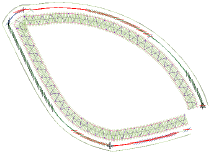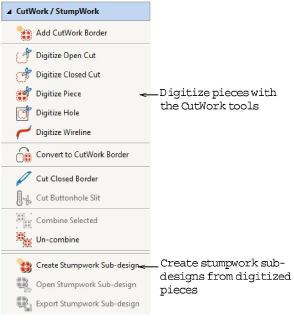Stumpwork concepts
 Most stumpwork involves the use of wirelines to provide body and shape to the raised object. The process involves first sewing a guidetrack within which to place the wireline. Next a tackdown is used to sew the wireline into position within the guidetrack. Finally cover stitching is added, usually satin.
Most stumpwork involves the use of wirelines to provide body and shape to the raised object. The process involves first sewing a guidetrack within which to place the wireline. Next a tackdown is used to sew the wireline into position within the guidetrack. Finally cover stitching is added, usually satin.
Tip When creating stumpwork sub-designs, any embroidery within the stumpwork border will be treated part of the stumpwork.
Stumpwork border components
Stumpwork borders consist of some or all of the following ‘Piece’ border components. Each is separated in the stitching sequence by a machine stop.
|
Components
|
Notes
|
|

|
Inner stabilizing run
|
This is internal to the stumpwork. It is not needed with wireline embroidery but may be required with other embroidery types. Stabilizing runs are used to reduce any deformation in the material prior to embroidery.
|
|

|
Embroidered border
|
Typical stumpwork makes use of a wireline but other borders may be used.
|
|
|
Stop
|
If you use wireline, all necessary stitching and stops are included to allow you to place and sew the wireline.
|
|

|
Outer stabilizing run
|
This is external to the stumpwork. This is generally used to stabilize the fabric for cutting.
|
|
|
Stop
|
Change to a cutting tool or cut stumpwork out by hand.
|
|

|
Cutting line
|
A cutting line is automatically generated for the CutWork tool to follow.
|
StumpWork tools
In BERNINA Embroidery Software, stumpwork is considered a form of cutwork. It involves firstly the creation of cutwork pieces and then their transformation into stumpwork sub-designs. The CutWork / StumpWork toolbox contain all tools needed to digitize stumpwork pieces from scratch or create from existing embroidery.

-
The Digitize Piece tool allows you to create cutout fabric pieces with an embroidered border, usually wireline for stumpwork. It may include stabilizing runs before and/or after the embroidered border followed by a cutting line.
-
The Digitize Closed Cut tool can also be used to create cutout fabric pieces without an embroidered border. This can then be used to create a stumpwork sub-design.
-
Alternatively, the Add CutWork Border tool allows you to create stumpwork pieces from existing embroidery.
-
The CutWork / StumpWork toolbox allows you to create, edit, and save cutwork ‘sub-designs’. In effect, these are embedded designs which are displayed as part of the ‘base design’ but are not included in the stitchout. Instead, they are stitched out as separate components.
-
For additional support, the Digitize Wireline tool allows you to add wirelines to an existing stumpwork piece.
-
The Cut Closed Border tool is generally used for stumpwork pieces which include a wireline. Use this tool to cut a closed border and leave an opening for wire ends.
Production recommendations
Here are some recommendations for producing stumpwork on the machine:
-
Use the 44C foot. It is transparent and is large enough to help hold the wire in place as it is tacked down.
-
Use a foot control when tacking down the wire – it’s easier to stop and start that way.
-
Reduce to slow speed with the sliding speed control.
-
After the wire is tacked down, it is ok to stitch at fast speed.
-
When working with a stumpwork piece that has additional wirelines – such as a leaf with central veins – make sure the internal wires do not overlap the border.
-
Alternatively, cut the internal wires slightly short. This means that stitching can continue right up to the border, thereby avoiding unwanted gaps.
 Most stumpwork involves the use of wirelines to provide body and shape to the raised object. The process involves first sewing a guidetrack within which to place the wireline. Next a tackdown is used to sew the wireline into position within the guidetrack. Finally cover stitching is added, usually satin.
Most stumpwork involves the use of wirelines to provide body and shape to the raised object. The process involves first sewing a guidetrack within which to place the wireline. Next a tackdown is used to sew the wireline into position within the guidetrack. Finally cover stitching is added, usually satin.




